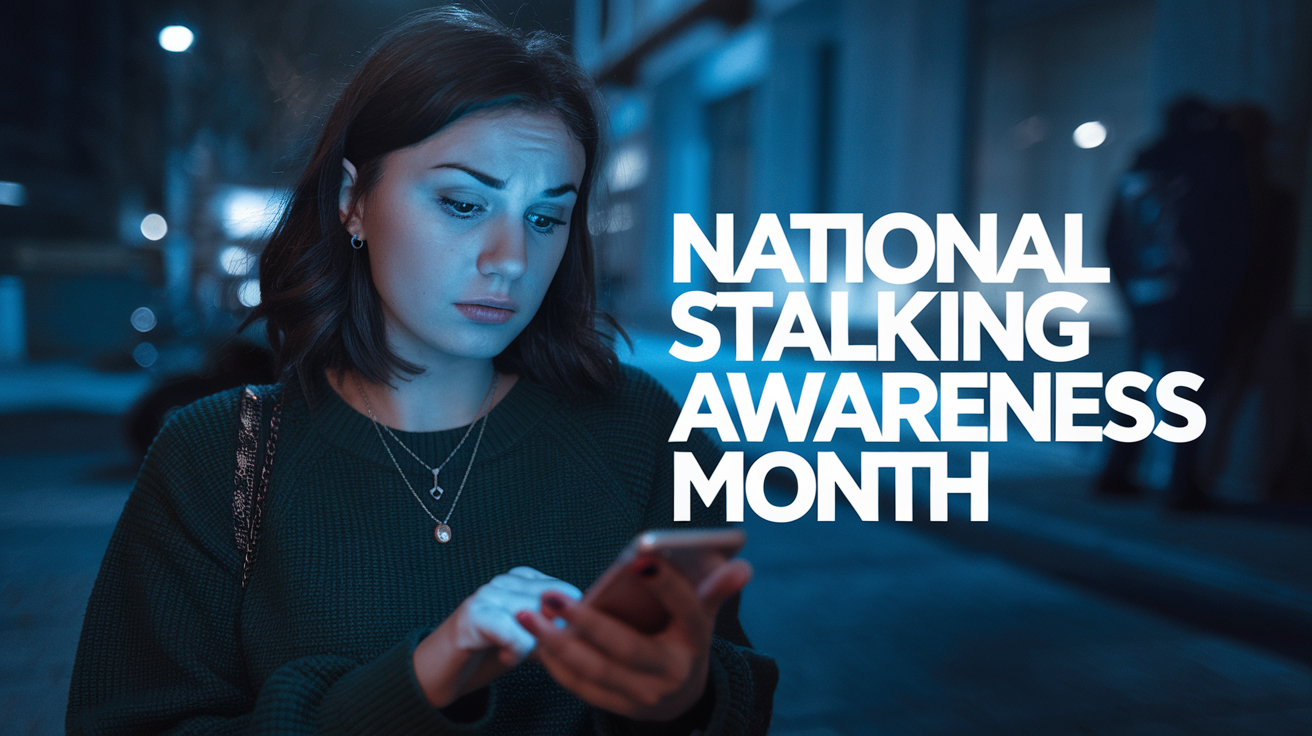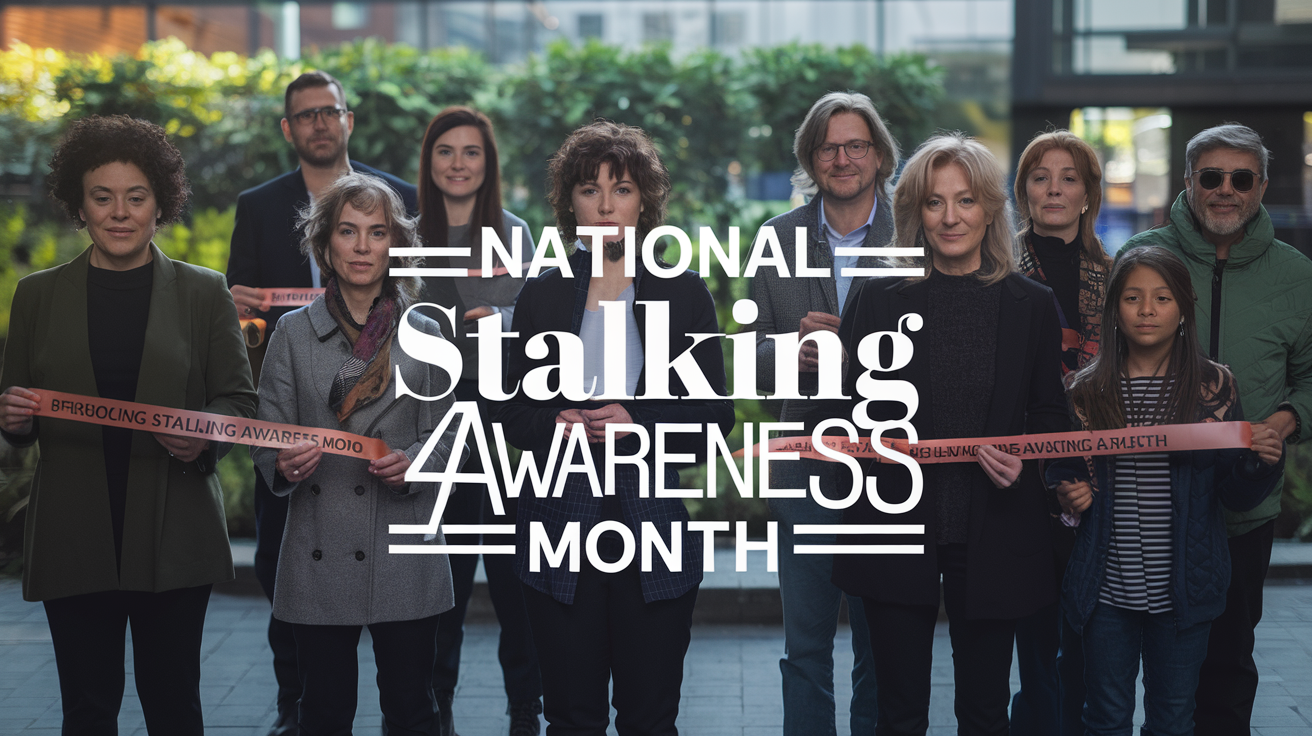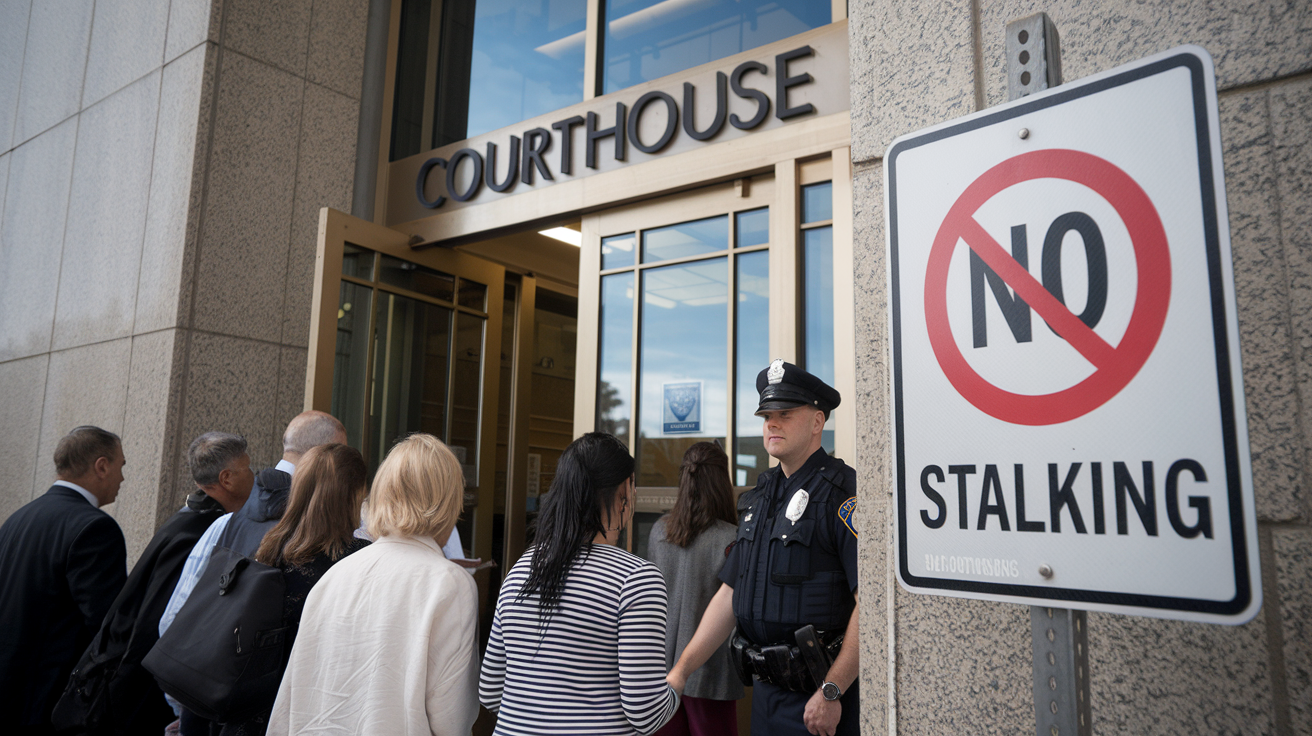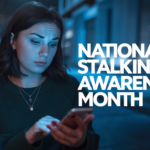
National Stalking Awareness Month: How to Get the Safety You Deserve
Have you ever felt like someone was watching your every move? That uneasy feeling in the pit of your stomach when you think you’re being followed? If so, you’re not alone. Stalking is a serious issue affecting millions worldwide, and it’s time we talked about it.
January marks National Stalking Awareness Month, a crucial time to spotlight this often-overlooked crime. Stalking isn’t just a plot device in thriller movies; it’s a real and terrifying experience for many. But here’s the good news: you don’t have to face it alone.
In this blog post, we’ll dive deep into stalking awareness, exploring everything from recognizing the signs to implementing practical safety measures. We’ll uncover the legal protections available to you, navigate the treacherous waters of digital stalking, and show you how to build a rock-solid support network. So, buckle up and get ready to empower yourself with the knowledge and tools you need to reclaim your safety and peace of mind.
Understanding Stalking: Recognizing the Signs

A. Definition of stalking
Stalking is a pattern of repeated and unwanted attention, harassment, contact, or any other behavior directed at a specific person that would cause a reasonable person to feel fear or significant emotional distress. This persistent conduct can manifest in various forms, including physical pursuit, electronic surveillance, or unwelcome communication. It’s important to note that stalking is not limited to romantic relationships and can occur between strangers, acquaintances, or even family members.
B. Common stalking behaviors
Stalkers often employ various tactics to monitor, control, or intimidate their victims. These behaviors may include:
- Repeatedly calling, texting, or messaging the victim
- Following or showing up unexpectedly at the victim’s home, workplace, or other frequented locations
- Sending unwanted gifts or letters
- Damaging the victim’s property
- Threatening the victim or their loved ones
- Using technology to track or spy on the victim
- Spreading rumors or false information about the victim
C. Types of stalkers
Stalkers can be categorized into several types, each with distinct motivations and behavior patterns:
- Intimate partner stalkers: Often former partners seeking reconciliation or revenge
- Delusional stalkers: Individuals with mental health issues who believe they have a relationship with the victim
- Predatory stalkers: Those who stalk with the intent to assault or harm the victim sexually
- Celebrity stalkers: Individuals obsessed with public figures or celebrities
D. Impact on victims
The effects of stalking on victims can be profound and long-lasting. Victims may experience:
- Constant fear and anxiety
- Depression and post-traumatic stress disorder (PTSD)
- Sleep disturbances and nightmares
- Social isolation and withdrawal
- Financial strain due to necessary safety measures or relocation
- Difficulty maintaining employment or relationships
- Physical health problems stemming from chronic stress
Understanding these signs and impacts is crucial for recognizing stalking behavior and seeking help. Next, we’ll explore the importance of National Stalking Awareness Month in addressing this serious issue.
The Importance of National Stalking Awareness Month

History and purpose of the awareness campaign
National Stalking Awareness Month, observed every January, was established in 2004 to shed light on the pervasive issue of stalking. The campaign aims to educate the public, law enforcement, and victim service providers about stalking and its devastating impact on victims. By raising awareness, the initiative seeks to improve victim identification, enhance support services, and promote effective interventions to combat stalking.
Key statistics on stalking prevalence
Recent studies reveal alarming statistics about stalking in the United States. Approximately 1 in 6 women and 1 in 17 men have experienced stalking in their lifetime. Even more concerning, 54% of femicide victims reported stalking to the police before being killed by their stalkers. These numbers underscore the urgent need for increased awareness and action to address this serious issue.
Why increased awareness matters
Increased awareness about stalking is crucial for several reasons. First, it helps potential victims recognize the signs of stalking early, enabling them to seek help and protection sooner. Second, it encourages bystanders to intervene and support those experiencing stalking. Third, heightened awareness can improve policies and legislation to protect victims and hold perpetrators accountable. Lastly, it reduces the stigma surrounding stalking, making it easier for victims to come forward and seek the help they need. As we delve deeper into the legal protections available against stalking, it’s clear that awareness is the first step toward effective prevention and intervention.
Legal Protections Against Stalking

Federal anti-stalking laws
Federal anti-stalking laws provide a crucial layer of protection for victims across the United States. The Interstate Stalking Punishment and Prevention Act of 1996 makes it a federal crime to cross state lines with the intent to injure or harass another person. This law also covers cyberstalking, recognizing the evolving nature of stalking in the digital age. Additionally, the Violence Against Women Act (VAWA) includes provisions that address stalking, offering further legal recourse for victims.
State-specific legislation
While federal laws provide a foundation, state-specific legislation offers more comprehensive protection. Many states have enacted their anti-stalking laws, which may define stalking more broadly and impose stricter penalties. These laws can vary significantly from state to state, so victims must familiarize themselves with their local regulations.
Obtaining restraining orders
Restraining orders, also known as protective orders or orders of protection, are powerful legal tools for stalking victims. These court-issued documents prohibit the stalker from contacting or approaching the victim. To obtain a restraining order, victims typically need to provide evidence of stalking behavior and demonstrate a reasonable fear for their safety. While the process can vary by jurisdiction, it generally involves filing a petition with the local court and attending a hearing.
Reporting stalking incidents effectively
Effective reporting is crucial for building a strong legal case against a stalker. Victims should document all incidents, including dates, times, and detailed descriptions of the stalker’s actions. Preserving evidence such as text messages, emails, or voicemails is also essential. When reporting to law enforcement, provide as much information as possible and request a copy of the police report. Consistent and thorough reporting helps establish a pattern of behavior, which is often key in stalking cases.
Technology and Stalking: Staying Safe in the Digital Age

Cyberstalking tactics
In the digital age, stalkers have expanded their arsenal to include various online methods. Cyberstalking can involve constant messaging, monitoring social media activity, GPS tracking, or even hacking into personal accounts. Stalkers may also use spyware to gather information or create fake profiles to harass their victims. Understanding these tactics is crucial for recognizing and addressing cyberstalking.
Protecting your online presence
To safeguard yourself from cyberstalking, review and strengthen your privacy settings on all social media platforms. Use strong, unique passwords for each account and enable two-factor authentication. Be cautious about sharing personal information online and consider using a virtual private network (VPN) to protect your internet activity. Regularly Google yourself to check what information is publicly available and take steps to remove any sensitive data.
Using technology for personal safety
While technology can be used for stalking, it can also be a powerful tool for protection. Consider using personal safety apps that quickly alert trusted contacts in an emergency. Some apps even offer features like virtual escorts or automatic location sharing. Smart home devices can enhance security with features like doorbell cameras and motion sensors. Remember to keep your devices’ software updated to maintain their security features.
Documenting digital evidence
If you’re experiencing cyberstalking, it’s crucial to document all incidents. Take screenshots of threatening messages, unwanted contact attempts, or suspicious online activity. Keep a detailed log of each occurrence’s dates, times, and descriptions. This documentation can be invaluable when reporting to law enforcement or seeking legal protection. Use secure cloud storage to back up this evidence, ensuring it’s safe even if your devices are compromised.
Building a Support Network

Confiding in trusted friends and family
Building a strong support network is crucial for stalking victims. Start by confiding in trusted friends and family members about your situation. Choose individuals who can provide emotional support and practical assistance. Be honest about your experiences and fears, allowing them to understand the gravity of the situation. Their support can help alleviate feelings of isolation and provide a sense of safety.
Seeking professional counseling
Professional counseling is an invaluable resource for stalking victims. A therapist experienced in trauma and stalking cases can help you process your emotions, develop coping strategies, and work through any anxiety or PTSD symptoms. They can also assist in creating a safety plan and provide tools to maintain your mental health during this challenging time.
Joining support groups for stalking victims
Connecting with others who have experienced stalking can be incredibly empowering. Support groups offer a safe space to share experiences, exchange coping strategies, and find solidarity. These groups can be found online or in person and are often facilitated by mental health professionals or victim advocacy organizations. Participating in such groups can help reduce feelings of isolation and provide valuable insights from those who understand your situation firsthand.
Collaborating with victim advocates
Victim advocates are trained professionals who can provide crucial support and guidance. They can help you navigate the legal system, assist with safety planning, and connect you with additional resources. Advocates can also accompany you to court hearings, help file protection orders, and liaise with law enforcement on your behalf. Their expertise and support can be instrumental in ensuring your safety and helping you regain control of your life.
Practical Safety Measures for Stalking Victims

Creating a personal safety plan
A personal safety plan is crucial for stalking victims. Start by documenting all stalking incidents, including dates, times, and locations. Identify trusted individuals who can be contacted in emergencies and establish a code word to signal immediate danger. Keep important documents, spare keys, and emergency cash in a secure, easily accessible location. Plan multiple escape routes from your home and workplace, and memorize them.
Enhancing home security
Bolster your home’s security by installing sturdy locks, cameras, and motion-sensor lighting. Consider a home security system with 24/7 monitoring. Reinforce windows and doors, and always keep them locked. Be cautious about sharing your location on social media and limit access to your personal information online.
Staying vigilant in public spaces
When in public, remain aware of your surroundings. Vary your routes and routines to be less predictable. Park in well-lit areas and always have your keys ready. Consider carrying a personal alarm or pepper spray where legal. Trust your instincts – if something feels off, remove yourself immediately.
Changing daily routines strategically
Regularly alter your daily patterns to make it harder for a stalker to predict your movements. This includes changing your commute routes, shopping at different stores, and varying your exercise routines. Be cautious about sharing your schedule with others and consider using privacy settings on social media to limit who can see your posts.
Self-defense techniques and classes
Enrolling in self-defense classes can boost your confidence and provide valuable skills. Learn basic techniques for breaking free from holds and creating distance from an attacker. Additionally, practice situational awareness exercises to sharpen your ability to recognize and avoid potential threats.
Now that we’ve covered practical safety measures, let’s explore the various resources available to stalking victims so they can seek further help and support.
Resources for Stalking Victims

National helplines and hotlines
For immediate support and guidance, victims of stalking can turn to national helplines and hotlines. The National Center for Victims of Crime’s Stalking Resource Center operates a 24/7 VictimConnect Resource Center, providing confidential support, information, and referrals. The National Domestic Violence Hotline also offers round-the-clock assistance, recognizing that stalking often intersects with domestic violence.
Local law enforcement assistance
Local police departments play a crucial role in addressing stalking cases. Many have specialized units trained to handle stalking situations sensitively and effectively. Victims are encouraged to report incidents to their local law enforcement, who can help document the stalking, provide safety planning, and potentially intervene with the stalker.
Victim compensation programs
Many states offer victim compensation programs to assist stalking survivors with expenses related to their victimization. These programs can help cover counseling, medical bills, relocation expenses, and lost wages. Victims should contact their state’s victim services office to learn about eligibility and application processes.
Legal aid services
Navigating the legal system can be daunting for stalking victims. Legal aid services specializing in stalking cases can provide invaluable assistance. These services often offer free or low-cost legal representation, help obtaining restraining orders, and guidance on victim rights. Many domestic violence organizations also provide legal advocacy for stalking victims.
With these resources available, stalking victims can access the support and protection they need. Remember, no one has to face stalking alone, and help is always within reach.

Stalking is a serious issue that affects millions of people worldwide, and National Stalking Awareness Month serves as a crucial reminder of the importance of education, prevention, and support. By recognizing the signs of stalking, understanding legal protections, and implementing practical safety measures, individuals can take significant steps toward ensuring their safety and well-being. It’s equally important to stay vigilant in the digital realm, as technology has opened new avenues for stalkers.
Remember, you are not alone in this fight. Building a strong support network and utilizing available resources is essential to protecting yourself from stalking. If you or someone you know is experiencing stalking, don’t hesitate to ask for help. Your safety and peace of mind are paramount, and there are professionals and organizations ready to assist you in reclaiming your sense of security and freedom.
Serving all of North County San Diego, Lass Law delivers comprehensive legal representation in divorce and family law cases. The firm’s services include support for high net worth divorce, spousal support, child custody, and custody mediation. With a focus on clarity, compassion, and client empowerment, Lass Law is a trusted resource for local families. Begin your case with confidence by visiting the contact page.










